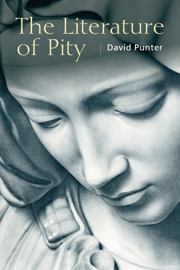Book contents
- Frontmatter
- Contents
- Plates
- Preface
- Acknowledgements
- 1 Distinguishing Pity
- 2 Pity and Terror: The Aristotelian Framework
- 3 Pietà
- 4 Shakespeare on Pity
- 5 The Eighteenth Century
- 6 Blake: ‘Pity would be no more …’
- 7 Aspects of Victoriana
- 8 Chekhov and Brecht: Pity and Self-Pity
- 9 ‘War, and the pity of War’: Wilfred Owen, David Jones, Primo Levi
- 10 Reflections on Algernon Blackwood's Gothic
- 11 Pity's Cold Extremities: Jean Rhys and Stevie Smith
- 12 Reclaiming the Savage Night
- 13 ‘Pity the Poor Immigrant’: Pity, Diaspora, the Colony
- 14 Lyric and Pity
- After Thought: Under the Dome
- Notes
- Bibliography
- Index
After Thought: Under the Dome
Published online by Cambridge University Press: 05 September 2014
- Frontmatter
- Contents
- Plates
- Preface
- Acknowledgements
- 1 Distinguishing Pity
- 2 Pity and Terror: The Aristotelian Framework
- 3 Pietà
- 4 Shakespeare on Pity
- 5 The Eighteenth Century
- 6 Blake: ‘Pity would be no more …’
- 7 Aspects of Victoriana
- 8 Chekhov and Brecht: Pity and Self-Pity
- 9 ‘War, and the pity of War’: Wilfred Owen, David Jones, Primo Levi
- 10 Reflections on Algernon Blackwood's Gothic
- 11 Pity's Cold Extremities: Jean Rhys and Stevie Smith
- 12 Reclaiming the Savage Night
- 13 ‘Pity the Poor Immigrant’: Pity, Diaspora, the Colony
- 14 Lyric and Pity
- After Thought: Under the Dome
- Notes
- Bibliography
- Index
Summary
Under the Dome (2009) is not Stephen King's best novel; indeed, it is distinctly ramshackle. Although it brings to something of a climax King's dealings with small-town USA, it sets out far too large a cast of characters, and eventually we lose effective sight of most of them, and the writing is occasionally rushed and clunky; however, it does in its closing pages provide a significant view of pity.
The plot, fantastical as it is, is easily told. An invisible but unbreakable dome descends one day over a small town in Maine; in doing so, it cuts various people and animals in half, but the principal effect is to provide an almost literal ‘hot-house’ within which existing rivalries and secrets move towards increasingly violent fruition. Although in some respect this is a typical small town, in others it is not: not many small towns in Maine, one may justly suspect, have a senior town official who is the kingpin in an international trade in hard drugs.
The nature and function of the dome are gradually revealed; it has been placed by a group of alien children who are using it in much the same way – in a metaphor which is stretched to its limit – as human children might torment and torture insects and small animals, regarding them – as the alien children regard us – as insensate and therefore unable to experience anxiety or pain.
- Type
- Chapter
- Information
- The Literature of Pity , pp. 167 - 170Publisher: Edinburgh University PressPrint publication year: 2014



